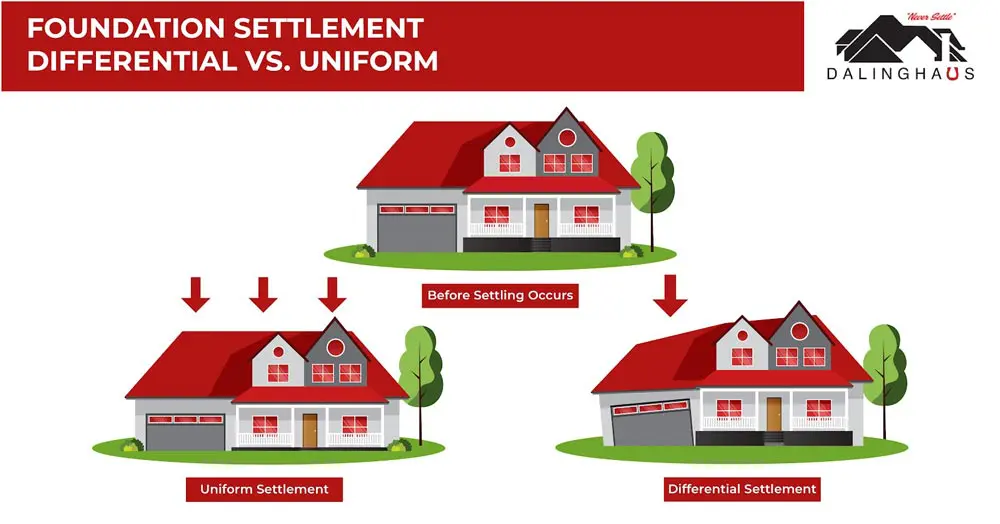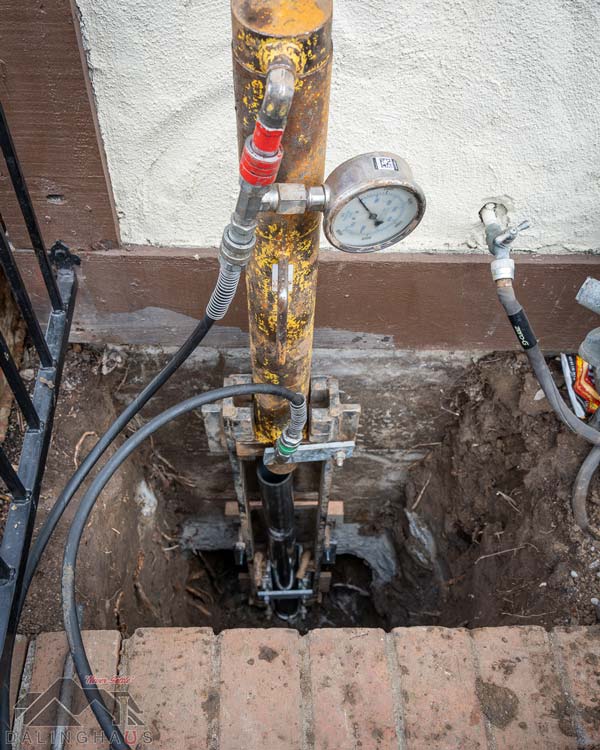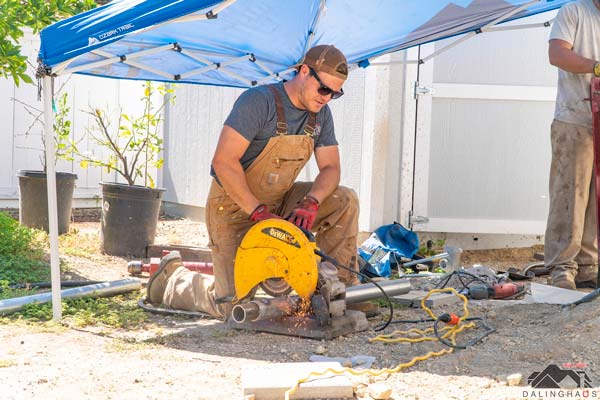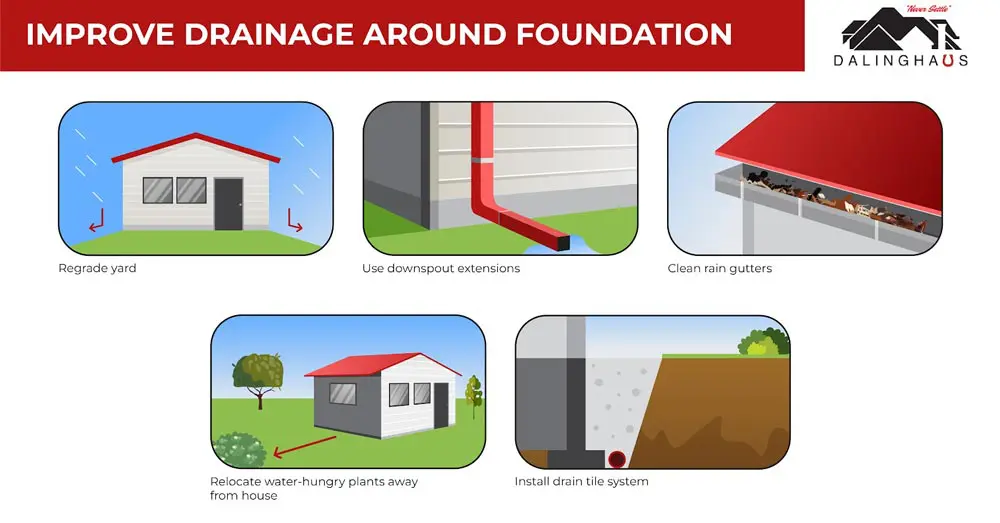Looking for information about the disadvantages of house lifting? If so, don’t hit that back button because you’ve landed on the right page. In this article, we’re going to go over the disadvantages of house lifting, why you should leave house lifting to the experts, how house lifting is done, why foundations sometimes need lifting, and more.
Why Do Houses Sometimes Need To Be Lifted?
The most common reason a house needs to be lifted is a phenomenon called “differential settlement,” or when a foundation settles into the soil unevenly. The best way to explain differential settlement is with an illustration:

Differential settlement places a lot of stress on a foundation and, if it isn’t corrected, will eventually cause severe structural damage.
So, what causes differential settlement?
Differential settlement is caused by various things, including expansive soil, erosion-prone soil, drought, large trees too close to the foundation, excavation too close to the foundation, seismic events, and poor construction practices.
When a house is experiencing differential settlement, it may require lifting to regain stability. Lifting, or underpinning, involves strengthening the foundation by excavating the soil around the affected area and installing piers to extend the foundation down to load-bearing soil.
For more information, see Understanding Foundation Raising and Differential Settlement.
What Is House Lifting, And How Is It Performed?

House lifting, more commonly known as underpinning, is a process that involves strengthening the foundation of a building by installing additional support structures underneath it. This is necessary when a building’s foundation becomes unstable or weakened due to exposure to unfavorable soil conditions or seismic activity. A common method of underpinning is the use of push or helical piers.
Push piers are steel tubes, typically 2 to 3 inches in diameter, that are hydraulically driven into the soil beneath the foundation of a building until they reach bedrock or a suitable load-bearing stratum. This not only provides additional support for the foundation but also helps to transfer the weight of the building to a stronger layer of soil.
Installing push piers involves excavating around the perimeter of the foundation and attaching heavy-duty steel brackets to the footing. The piers are then hydraulically driven through the brackets and into the soil until they reach the load-bearing strata. Once the piers are in place, a synchronized hydraulic lifting system raises the foundation to maximum practical level. In other words, the foundation is raised as much as possible without causing damage.
So, Are There Any Disadvantages Of House Lifting?
We wouldn’t use the term “disadvantages.” While house lifting (i.e., foundation underpinning) is sometimes necessary to ensure a building’s structural integrity, it has some negatives. These include the following:
- It’s expensive – Underpinning a foundation is a complex and costly repair. The cost of underpinning can vary depending on the size of the foundation, the extent of the damage, and the home’s geographical location.
- It requires excavation – Underpinning a foundation requires excavating around the foundation down to the footing. This means there could be damage to landscaping, sidewalks, or driveways.
- It might disrupt your daily routine – House lifting isn’t accomplished in a few hours. There will be a repair crew on your property for several days.
- There will be some noise – Underpinning involves noise, vibration, and dust.
Why You Should Leave House Lifting To The Experts

DIY house lifting may seem attractive for homeowners who want to save money on costly foundation repair services. However, attempting to lift a home without expert knowledge and equipment can pose serious risks to the homeowner and the property itself.
House lifting requires special equipment and training
If you’re going to lift a house to repair damage caused by foundation settlement, you will need specialized equipment and training. Without proper training and equipment, homeowners could very easily make the problem worse.
House lifting is dangerous
House lifting is a dangerous activity that requires careful planning and execution. Lifting a house involves heavy machinery such as hydraulic jacks. If they aren’t handled properly (provided you could even get your hands on the necessary machinery), the house may shift or become unstable, causing foundation damage or injury to those nearby.
Your repair probably won’t comply with local codes
Even if the house is successfully lifted, the project may still not pass local building codes. In many areas, house lifting requires permits, inspections, and compliance with building codes to ensure the safety and stability of the structure. Without these, the homeowner may face steep fines or legal penalties.
The risks and potential consequences of DIY house lifting far outweigh any potential cost savings. Homeowners should consult with experienced professionals to ensure a safe and successful house-lifting project that complies with all relevant codes and regulations.
House lifting using push piers is a job for the pros
Underpinning a foundation with piers is a complex and specialized procedure that requires careful thought, planning, and execution. It’s not something a homeowner should ever attempt as a DIY project. It’s unlikely a homeowner would even be able to acquire the equipment necessary to underpin a foundation.
Tips On How To Prevent Foundation Problems
Fortunately, homeowners can take proactive measures that will help prevent foundation problems. These include the following:
- Regularly clean your gutters – Clogged gutters can cause water to overflow and accumulate in the ground around the foundation. This can lead to erosion, the buildup of hydrostatic pressure, and water intrusion through the foundation wall.
- Use downspout extensions – Another essential preventive measure involves using downspout extensions to direct water several feet away from the foundation before release.
- Make sure the yard is graded correctly – Re-grade the yard, if necessary, to ensure groundwater drains away from the foundation. This will prevent excess moisture from building up in the soil around the foundation.
- Keep vegetation away from the foundation – Flowers and shrubs next to the house might look beautiful, but they can trap moisture, causing it to accumulate near the foundation.
- Install a drain tile system – When it comes to foundation waterproofing, nothing beats a drain tile system because it doesn’t simply erect a barrier to keep moisture out. It prevents excess moisture from building up in the ground around the foundation in the first place.

If you think your home might need lifting, contact us today to schedule a foundation evaluation. If we find a problem, we’ll give you a repair estimate. We serve Southern California, Arizona, and Nevada.






